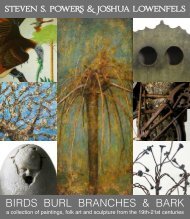FINDING NORTH
Outsider Art Fair 2019: FINDING NORTH - The subtitle to Friedrich Nietzsche’s Ecce Homo is “How One Becomes What One Is.” Considering Nietzsche’s directive, our title, “Finding North” is a metaphor for finding one’s path in life—one’s truth. Since no two of us are ever in the same position, our ways of finding north will always be different. Yes, some routes will be similar, but most will be vastly different. Some seeking north will walk paths straight and narrow, others loose and wide, while a few will plot hilly, twisty, and remarkably odd routes, but north nonetheless. A smooth, well-marked path is not necessarily the surest way north—finding oneself off course, momentarily lost may actually be more direct—so far as to regain the route northward. Some, on the other hand, ditch north altogether and head west or are off the grid entirely. The known artists herein walked, hiked, climbed (and probably tripped a few times) towards their truth. The others, we have no idea, because they are unknown or we don’t know enough about them or the lives they lead. But, all of them left something wondrous behind that helps us understand or consider them in a small or large way and in many cases, their wondrous works aid in our journey—we use their works to assist us in finding our north.
Outsider Art Fair 2019: FINDING NORTH - The subtitle to Friedrich Nietzsche’s Ecce Homo is “How One Becomes What One Is.” Considering Nietzsche’s directive, our title, “Finding North” is a metaphor for finding one’s path in life—one’s truth. Since no two of us are ever in the same position, our ways of finding north will always be different. Yes, some routes will be similar, but most will be vastly different. Some seeking north will walk paths straight and narrow, others loose and wide, while a few will plot hilly, twisty, and remarkably odd routes, but north nonetheless. A smooth, well-marked path is not necessarily the surest way north—finding oneself off course, momentarily lost may actually be more direct—so far as to regain the route northward. Some, on the other hand, ditch north altogether and head west or are off the grid entirely.
The known artists herein walked, hiked, climbed (and probably tripped a few times) towards their truth. The others, we have no idea, because they are unknown or we don’t know enough about them or the lives they lead. But, all of them left something wondrous behind that helps us understand or consider them in a small or large way and in many cases, their wondrous works aid in our journey—we use their works to assist us in finding our north.
Create successful ePaper yourself
Turn your PDF publications into a flip-book with our unique Google optimized e-Paper software.
FindinG N orth<br />
OUTSIDER ART FAIR: NEW YORK<br />
JANUARY 17-20, 2019
STEVEN S. POWERS<br />
Finding North<br />
The subtitle to Friedrich Nietzsche’s Ecce Homo is “How One<br />
Becomes What One Is.” Considering Nietzsche’s directive, our title,<br />
“Finding North” is a metaphor for finding one’s path in life—one’s<br />
truth. Since no two of us are ever in the same position, our ways of<br />
finding north will always be different. Yes, some routes will be<br />
similar, but most will be vastly different. Some seeking north will<br />
walk paths straight and narrow, others loose and wide, while a few<br />
will plot hilly, twisty, and remarkably odd routes, but north<br />
nonetheless. A smooth, well-marked path is not necessarily the<br />
surest way north—finding oneself off course, momentarily lost may<br />
actually be more direct—so far as to regain the route northward.<br />
Some, on the other hand, ditch north altogether and head west or<br />
are off the grid entirely.<br />
The known artists herein walked, hiked, climbed (and probably<br />
tripped a few times) towards their truth. The others, we have no<br />
idea, because they are unknown or we don’t know enough about<br />
them or the lives they lead. But, all of them left something<br />
wondrous behind that helps us understand or consider them in a<br />
small or large way and in many cases, their wondrous works aid in<br />
our journey—we use their works to assist us in finding our north.<br />
The Outsider Art Fair: New York<br />
January 17-20, 2019.<br />
Metropolitan Pavilion, 125 W 18th St, New York, NY 10011<br />
Show information: outsiderartfair.com<br />
W O R K S O F<br />
A R T<br />
& americana<br />
109 3rd Place #2, Brooklyn, NY 11231 | 718.625.1715 or 917.518.0809 | stevenspowers.com | member: ADA
Time’s Up! (detail)<br />
Nineteen vintage alarm clocks<br />
Circa: 1930-1950s<br />
Size: range from: 4" (d) - 7" (w)
Miroslav Tichy´:<br />
ETCHINGS<br />
Although Miroslav Tichý (1926-2011) was primarily<br />
known as a street photographer, he had a remarkable hand<br />
for drawing.<br />
Tichý practiced drawing from nude models at The<br />
Academy of Fine Arts (AVU) in Prague, however after the<br />
Soviet takeover in 1948, such practices became<br />
prohibited, and he was forced to draw from clothed<br />
models—he refused and was eventually expelled. Seeking<br />
a less politically oppressive environment, Tichý moved<br />
back to his provincial hometown of Kyjov,<br />
Czechoslovakia.<br />
Kyjov was a small, quiet town and not a hotbed of artistic<br />
or political activity, however, Tichý was labeled a political<br />
dissident and was routinely jailed or put into a mental<br />
health institution (Tichý had bouts of psychosis since his<br />
teenage years).<br />
Tichý’s drawing and painting style of the 1970s became<br />
charged with a quick staccato of lines versus the long<br />
flowing “fashion” lines of his previous work. His subjects<br />
(usually female) and style became more candid and<br />
natural like his street photography and not idealized.<br />
As a generality, Tichý’s almost exclusive study of the<br />
female form can be traced back as a reaction to the<br />
prohibition days at the academy.
Also during this period, Tichý began experimenting with monotype etchings.<br />
As with his tools for photography, his materials for engravings were<br />
improvised from recycled scraps of metal, plastic or wood. Tichý’s neighbor<br />
and come-biographer Roman Buxbaum, observed, “After scratching out the<br />
drawing he applied paint with the palm of his hand and then, applying<br />
pressure with a spoon, transferred it to paper.” The blurred lines and ink<br />
smears from this imperfect process resulted in etchings, not unlike his<br />
photographs, filled with a hazy and mysterious atmosphere.<br />
His wanderings around town, camera in hand were voyeuristic by default,<br />
not design. He was not known to be lewd or perverted. Tichý states, “Women<br />
are just a motif for me. The figure - standing, bending or sitting. The<br />
movement, walking. Nothing else interests me.”<br />
What is fascinating and commendable in Tichý’s print and photographic<br />
work is that he used mediums ideally suited for mechanical reproduction,<br />
multiple editions, however, so far as we know, Tichý only printed from his<br />
photographic negatives and print plates just once—all unique works.<br />
In the 2000s Buxbaum convinced Tichý that his work should be shown and<br />
organized an exhibit of his photography for the 2004 Biennial of<br />
Contemporary Art in Seville, Spain. Since then Tichý’s work has been<br />
recognized worldwide and has had major retrospectives at the Kunsthaus in<br />
Zurich in 2005, the Pompidou Centre in 2008, and the International Center of<br />
Photography, New York in 2010. His work is now part of most major<br />
institutional and private collections.<br />
(r) Miroslav Tichý (1926-2011)<br />
Untitled [Woman with Apple]<br />
Monotype etching<br />
Circa: 1970s (n.d.)<br />
Size: 11 3/4" (w) x 16 1/2" (h)
(r) Miro<br />
Untitled [W<br />
Siz<br />
(l) Miroslav Tichý (192<br />
Untitled [Woman Sitting<br />
Monotype etching<br />
Circa: 1970s (n.d.)<br />
Size: 9 1/2" (w) x 15 3/
6-2011)<br />
]<br />
4" (h)<br />
slav Tichý (1926-2011)<br />
oman Trying on Shoes]<br />
Monotype etching<br />
Circa: 1970s (n.d.)<br />
e: 9" (w) x 15 1/4" (h)
Miroslav Tichý (1926-2011)<br />
Untitled [An Artist in Her Studio]<br />
Monotype etching<br />
Circa: 1970s (n.d.)<br />
Size: 11" (w) x 16" (h)
Miroslav Tichý (1926-2011)<br />
Untitled [Woman Turned Right - Maroon]<br />
Monotype etching<br />
Circa: 1970s (n.d.)<br />
Size: 7 1/4" (w) x 13 1/2" (h)<br />
Miroslav Tichý (1<br />
Untitled [Woman B<br />
Monotype etching<br />
Circa: 1970s (n.d<br />
Size: 6 1/4" (w) x
926-2011)<br />
ackside - Bikini]<br />
)<br />
13" (h)<br />
Miroslav Tichý (1926-2011)<br />
Untitled [Woman Turned Left - Indigo]<br />
Monotype etching<br />
Circa: 1970s (n.d.)<br />
Size: 5 3/4" (w) x 11 1/4" (h)
Miroslav Tichý (1926-2011)<br />
Untitled [Woman Turned Right]<br />
Monotype etching<br />
Circa: 1970s (n.d.)<br />
Size: 6 1/2" (w) x 10" (h)<br />
Miroslav Tichý (19<br />
Untitled [Woman B<br />
Monotype etching<br />
Circa: 1970s (n.d.)<br />
Size: 6" (w) x 8 1/
26-2011)<br />
ackside - Naked]<br />
2" (h)<br />
Miroslav Tichý (1926-2011)<br />
Untitled [Woman Turned Left]<br />
Monotype etching<br />
Circa: 1970s (n.d.)<br />
Size: 6 1/2" (w) x 8 1/2" (h)
Miroslav Tichý (1926-2011)<br />
Untitled [Woman in a White Tank-Top]<br />
Unique gelatin silver print on Tichý mat<br />
Circa: 1960-1980 (n.d.)<br />
Size: 5" (w) x 6 3/4" (h)
Miroslav Tichý (1926-2011)<br />
Untitled [Magenta Nude]<br />
Watercolor and ink on paper<br />
Circa: 1960s (n.d.)<br />
Size: 17" (w) x 12" (h)
Miroslav Tichý (1926-2011)<br />
Untitled [Portrait of a Woman]<br />
Oil on paper<br />
Circa: 1960s (n.d.)<br />
Size: 16" (w) x 22" (h)
Bare Naked Beach Bingo<br />
Sixteen handmade erotic “Barbie” figures<br />
Low fired ceramic and glazes<br />
Circa: early-mid 1960s<br />
Size range from: 4" (h) - 11 1/2" (h)<br />
Provenance: Marvill Collection<br />
Literature: American Vernacular, pps. 160-161<br />
Exhibted: Museum of Sex, Known/Unknown, 2017
Frederick Hastings (1919-2013)<br />
A Group of Five Figures<br />
Steel, air-dried clay, paint, cardboard, cotton, lead and masking tape<br />
Circa: 1960-80<br />
Sizes range from: 2 1/2" - 7 1/4" (oah)<br />
The works of Frederick Hastings were discovered a few years ago, and<br />
much of the details of his life and work remains a mystery. The two<br />
larger figures are made from steel armatures under air dried clay, and<br />
the smaller three are steel armatures under painted lead.<br />
What is known is that he lived outside of Philadelphia, was an architect<br />
and may have had family money. It is also known that he was into<br />
trains and built elaborate sets.<br />
The figures are very well made, with steel armatures or skeletons and<br />
then carefully modeled with some air-dried clay or modeling putty.<br />
Most have applied paper bikinis, and several have wigs of cotton or<br />
wool. Most of the figures come with hand-made boxes, custom fit to<br />
accommodate the size and posture of each.<br />
At first glance, the figures appear hermaphroditic or trans-gendered.<br />
However, none have genitals—just muscular bodies with breasts. And<br />
though a significant effort is put into modeling and composing the<br />
figures, there appears to be no attempt to idealize or beautify the<br />
faces—which are often quite severe and grotesque.<br />
During the same period in which Forrest Bess was exploring sexuality<br />
through hermaphroditism, Hastings was engaged in exploring the<br />
boundaries of masculinity and femininity.
Many Mons Pubis<br />
Photographic process on an uncut sheet of paper stamps<br />
Circa: 1930<br />
Size: 12 1/2" (w) x 8 1/2" (h)<br />
This is quite a remarkable and mysterious work of art.<br />
Many “artist unknown” artworks have kept me up at<br />
night, and this is no exception.<br />
The work shows the pubic area of thirty-six different<br />
women (one shaven). Possibly purposely ambiguous, at<br />
first glance the subjects may look like trees, upturned<br />
umbrellas, or even tornadoes. (“Hell hath no fury...”)?<br />
The halftone printing enables us to see the subject<br />
clearly at arm’s length, but as we move closer, we do not<br />
see more detail, we see less—the dots of the printing<br />
process decrease the detail and makes it more<br />
abstract— thus the labels under each subject<br />
(presumably the model’s name) become increasingly<br />
unclear.<br />
Process-wise it appears that each subject was<br />
photographed, printed, labeled, framed and then shot<br />
again—then possibly a composite of the whole was<br />
photographed and then printed onto the sheet of<br />
stamps.<br />
Regardless of the artist’s identification, objectively the<br />
work is a tour-de-force in concept and execution and<br />
recalls motifs of the Dada and Fluxes movements.<br />
Though it has nothing to do with the work herein,<br />
coincidentally, the British photographer, Alisa Connan<br />
created a similar work, entitled “Project Bush” in 2013.
A Rare Pewter Mounted Enamel Snuffbox<br />
in the Form of Female Genitalia.<br />
Circa 1780-1800.<br />
Size: 3 3/8" L x 1 5/8" W x 1 1/4" H.<br />
An overt twist on the traditional enamel or<br />
cowry shell pewter or silver mounted snuff<br />
box.<br />
A few years ago, I had a similar example<br />
with glazed pubic hair—“unshaven” it is<br />
slightly more abstract and looks like a<br />
Hindu yoni graphic—which, of course<br />
represents the vulva.<br />
Literature: A related example is illustrated<br />
in, ART OF THE LIMOGES BOX, p. 40.
Time’s Up!<br />
Nineteen vintage alarm clocks<br />
Circa: 1930-1950s<br />
Size: range from: 4" (d) - 7" (w)<br />
Provenance: John & Teenuh Foster Collection
These alarm clocks were found in a room within an abandoned house<br />
in Wisconsin. Individually, they are cool, but not important—as a<br />
collection they make a strong conceptual and mysterious statement.<br />
Exhibitions: James Madison University, Duke Gallery and New Image<br />
Gallery, Harrisonburg, VA, 2015; and The Mitchell Museum, Mount<br />
Vernon, IL, 2017.
Forrest Bess (1911 – 1977)<br />
Untitled [Three Figures]<br />
Oil on canvas<br />
Circa: 1946<br />
Size: 16" (w) x 14" (h)<br />
Provenance: Kirk Hopper Fine Art, Parrasch Heijnen Gallery.<br />
In 1946 Forrest Bess found himself as a painter. Although Bess had<br />
produced works in the 1930s, it was not until 1946 that Bess, at the<br />
urging of his psychiatrist, began to record the colorful visions that were<br />
troubling him. The visions were likely brought on from the trauma he<br />
suffered from being beaten by a fellow Army mate as a consequence of<br />
his homosexuality. In this year, Bess produced a wide range of work<br />
from representational, abstract and symbolic paintings. About this<br />
period, Bess expressed to his dealer, Betty Parsons, “Only by painting<br />
the goddamned thing out have all my symptoms of anxiety<br />
disappeared.” It was these works that got him through his PTSD and<br />
on his way to the visionary painter he would become.<br />
Bess’s paintings were an integral part of his being which was heavily<br />
influenced by Carl Jung’s thoughts on symbolism, Australian aboriginal<br />
initiation rites and the belief that the hermaphrodite was “the desired<br />
and intended state of man.” His commitment to this philosophy<br />
culminated in the self-surgery on his genitals in the late 1950s.<br />
Among the works created in 1946 are three related figural works. The<br />
painting herein, one from the esteemed Harry Burkhart Collection, and<br />
another in a private collection.<br />
The three works were likely produced in quick succession, one after
“All my life I have been an<br />
outsider looking at beauty”<br />
— Forrest Bess to Betty Parsons
the other. They each have groups of solidly painted figures that define<br />
the space and foreboding environments. The moody works are<br />
punctuated with blocks of primary and secondary colors—they are<br />
surely direct responses to the colorful visions and trauma that Bess had<br />
discussed with his therapist.<br />
In the untitled work herein, two figures have cornered a third—it feels<br />
like an act of violence is about to occur. The reddish figure appears<br />
defensive and raises his left arm to push away the two blue beings<br />
closing in on him. Though flatly rendered the figures have a keen sense<br />
of form and movement.<br />
Though Bess would become widely known for his visionary works and<br />
show at the Betty Parsons Gallery alongside Mark Rothko and Jackson<br />
Pollock, it was through the figural works of 1946 that allowed Bess to<br />
free himself and explore his symbolic work.<br />
Forrest Bess was the subject of a retrospective at the Hammer Museum<br />
in 2013/2014 and was featured in the 2012 Whitney Biennial. His work<br />
is part of numerous museum and private collections, including the<br />
Menil Collection, Houston, the Museum of Contemporary Art, Chicago,<br />
Museum of Modern Art in New York, and Whitney Museum of American<br />
Art in New York.<br />
Several of Bess’ works are part of the exhibit "Outliers and American<br />
Vanguard" organized by The National Gallery, and currently at the Los<br />
Angeles County Museum of Art.
“ONLY BY PAINTING THE<br />
goddamned thing out have<br />
all my symptoms of anxiety<br />
disappeared.”<br />
— Forrest Bess to Betty Parsons<br />
Photo of Bess from,<br />
"His Name Was Forrest<br />
Bess" by Michael Ennis,<br />
Texas Monthly, June 1982<br />
Undated photo of Bess at his<br />
house/studio in Chinquapin,<br />
Texas.
Drawings and Letters from<br />
The Kansas State Insane<br />
Asylum at Osawatomie
This important cache of eleven drawings and writings by MW Demorest, an inmate at the<br />
Kansas State Insane Asylum in the 1890s provides rare documentation by an actual inmate<br />
of an early American mental institution.<br />
At this time, not much is known about MW Demorest. According to a local newspaper,<br />
Demorest of Ottawa, Kansas, was institutionalized shortly after setting off a rash of fires in<br />
November 1889. His mother Catherine died at the age of ninety in 1909 and owned a fair<br />
amount of land. He had several siblings, and these drawings and writings were intended for<br />
them. Two of the pages are dated 1892, and we assume the others date to around that period.<br />
The drawings are on ruled and unruled paper—some on scraps. The writings on the reverse<br />
are densely written and without punctuation—reading them is fairly tricky. Several of them<br />
look like numerological charts and have statements like, “there R 3,586,483 letters in the<br />
Bible,” and much of the copy is about praising God. However, Demorest gives us some<br />
insight into his condition. He does not trust his caretakers and writes, “I have no chance to<br />
send anything out of this institution...the superintendent...he reads every letter [and] if there<br />
is anything in it they do not like, they do not send it [and] therefore we have to be careful<br />
what we say.”<br />
He repeatedly writes that he has “dreams and visions,” mostly regarding an idea he has of<br />
building a boat. “I see a great boat flashed on the wall, as though it was thrown there by a<br />
great magic lantern...I am sure I could make that<br />
boat and that it would get over the water as fast as<br />
any train will move on land”<br />
In another he writes, “...and God caused me to<br />
fall into a deep sleep and caused me to see a<br />
wonderful vision of a large boat and a man’s hand<br />
on a center large lever which caused the paddler<br />
to rush from one end of the boat to the other like<br />
they were run by electricity.” He twice states that<br />
he should, “go to Washington and get a patent on<br />
that boat.”<br />
It is not known how long Demorest was<br />
institutionalized, but he expressed, “I often think,<br />
I would like to know when I will be free, but<br />
that is what I do not know - last spring, I felt in<br />
hopes, I would be free in time to put a boat on<br />
the river.”<br />
above: detail of drawing on right with light<br />
shining from behind.
(previous page)<br />
MW Demorest<br />
Garden of Eden<br />
Kansas Insane Asylum<br />
Circa: April 30, 1892<br />
Size: 9 3/4" (h) x 7 3/4"<br />
(w)<br />
(r) MW Demorest<br />
Sleeping Beauty with Winged<br />
Angel and Rainbow<br />
Kansas Insane Asylum<br />
Circa: 1892<br />
Size: 8" (h) x 5" (w)
On this and the p<br />
Demorest uses a n<br />
drawing the wom<br />
eyes, as if sleepin<br />
when a light is sh<br />
behind, the eyes “<br />
“awakens.” It is b<br />
somewhat, unexp<br />
above: detail of draw<br />
light shining from be<br />
MW Demorest<br />
Sleeping Beauty an<br />
Kansas Insane Asy<br />
Circa: 1892<br />
Size: 8 1/2" (h) x
ing on left with<br />
hind.<br />
revious drawing,<br />
ovel device of<br />
n with closed<br />
g. However,<br />
own from<br />
open” and she<br />
oth clever and<br />
ectedly creepy.<br />
d Boy in Boat<br />
lum<br />
5 3/8" (w)<br />
MW Demorest<br />
“Let Him Fly”<br />
Kansas Insane Asylum<br />
Circa: March 22, 1892<br />
Size: 11" (h) x 8 1/2" (w)
MW Demorest<br />
Birds of a Feather<br />
Mixed media on paper<br />
Circa: 1892<br />
Size: 8 1/2" (h) x 11" (w)
MW Demorest<br />
Portraits of a Man and Woman<br />
Kansas Insane Asylum<br />
Circa: 1892<br />
Size: 8 1/2" (h) x 11" (w)<br />
These next three drawings feature<br />
portraits—possibly of family<br />
members.<br />
It is interesting to point out that the<br />
woman to the right in these three<br />
portraits are the same woman,<br />
drawn identically—and on the<br />
following two, the woman on the<br />
left is the same, drawn identically.
MW Demorest<br />
Portraits of Two Women<br />
Kansas Insane Asylum<br />
Circa: 1892<br />
Size: 8" (h) x 9 7/8" (w)
MW Demorest<br />
Portraits of Three Women<br />
Kansas Insane Asylum<br />
Circa: 1892<br />
Size: 8 1/2" (h) x 11" (w)<br />
On all three portraits, Demorest pays<br />
particular attention to the details of<br />
the clothing—as if he is drawing each<br />
thread.<br />
The woman of the left here is holding<br />
an open Bible and Demorest writes<br />
phrases in tiny script.
This image shows the back of one of the sets of<br />
portraits—all three are like this.<br />
On the left, Demorest codifies various chapers,<br />
verses, and lines of the Bible.<br />
He writes “Verses I have found to B[e] H[elpful]”<br />
and systematically breaks down different books,<br />
like Exodus, Leviticus, Numbers, Samuel, etc...<br />
On the back of another, he writes numerological<br />
statements, e.g. “there R 3,586,483 letters in the<br />
Bible; 779,693 words; 31,373 verses...the word<br />
Lord is 7,773...the word King is 2,000.”<br />
On the right side of this example, he addresses<br />
his sister Reana. Within the ruled paper,<br />
Demorest squeezes in two lines of text within one<br />
ruled space—and does not use punctuation!
“I am held here like Joseph...<br />
[and] I would often get some<br />
discouraged, but when I read<br />
about Daniel being cast in the<br />
lion’s den and Joseph being cast<br />
in prison 14 years, I feel I ought<br />
to be willing to try and stand it 2<br />
years longer.”<br />
—MW Demorest,<br />
Kansas State Insane Asylum<br />
MW Demorest<br />
Daniel in the Lion’s Den<br />
Kansas Insane Asylum<br />
Circa: 1892<br />
Size: 7 3/4" (h) x 9 3/4" (w)
MW Demorest<br />
Baby Jesus on Striped Book (with detail le<br />
Kansas Insane Asylum<br />
Circa: 1892<br />
Size: 8 1/2" (h) x 10 1/2" (w)
ft)<br />
MW Demorest<br />
Winged Angel with Rainbow<br />
Kansas Insane Asylum<br />
Circa: 1892<br />
Size: 6" (h) x 5 3/8" (w)
Ida Jones (1874-1959)<br />
Mock Orange [Philadelphus]<br />
Oil on canvas board<br />
Circa: July, 1952<br />
Size: 20" (w) x 16" (h)<br />
Mockorange, (Philadelphus), is a shrub with a citrus scent and has<br />
white blossoms that bloom in the late spring to early summer. A<br />
portion of this painting can be seen in the upper left corner of the<br />
photo herein— Jones in her living room/studio.<br />
Ida Jones, the daughter of a former slave, had ten children and at the<br />
age of seventy-two began painting. Self-taught, her work focuses on<br />
local (Chester County, PA) landscapes, still-lifes and Biblical stories<br />
The Chester County Historical<br />
Society held a retrospective exhibit<br />
in 1995 and Jones was recently<br />
included in “We Speak: Black<br />
Artists in Philadelphia, 1920s-<br />
1970s, ” 2015.<br />
Literature: Starting Anew After<br />
Seventy: The Story of Ida Ella<br />
Jones, Primitive Artist, by Ida J.<br />
Williams, 1980.<br />
To Everything a Season: The Art<br />
and Life of Ida Jones, by Sheppard<br />
and Townsend, 1995.<br />
Photo of Jones at the easel in her living room. A<br />
portion of this painting is shown in the upper left<br />
corner. Photo circa 1955.
Dilmus Hall (1900-1987)<br />
Lamb<br />
Concrete, rebar, paint<br />
Circa: 1970’s<br />
Size: 18" (l) x 10" (w) x 13 1/4" (h)<br />
Provenance: Barbara Archer Gallery; Larry Dumont Collection<br />
As a child Hall would fashion small sculptures made from flour<br />
mixed with tree sap. Discouraged by his father, he didn’t pursue art<br />
until later in life.<br />
After serving in WWI as a stretcher bearer, he returned to Georgia<br />
and worked as a hotel bell captain, a sorority house busboy and then<br />
as a fabricator of concrete blocks for a construction company. It was<br />
here that Hall found himself<br />
again—working with his hands.<br />
He began making concrete<br />
sculpture around his home. His<br />
sculpture combined a mix of<br />
Christianity with an African<br />
conjuring culture that empowered<br />
objects with protective powers.<br />
Later he would make little<br />
tableaus with wood and putty that<br />
recall the modeling technique he<br />
developed as a child.<br />
Still image from the documentary, The<br />
Mind's Eye, with Hall at his home, circa<br />
1987.
Photo of Joseph Garlock,<br />
circa 1944, in front of his<br />
store, Bloomfiled, NJ<br />
Joseph Garlock<br />
immigrated from Russia<br />
to New York in 1904.<br />
After a bunch of odd<br />
jobs, Garlock and his<br />
wife settled in<br />
Bloomfield, NJ as the<br />
owners of a small fruits<br />
and vegetable store. In<br />
1948 he retired, and at<br />
sixty-four years, he<br />
found himself itching<br />
for something creative<br />
to do with his time.<br />
For the next several years, Garlock painted<br />
and sculpted somewhat compulsively. He<br />
painted at home and a while visiting his<br />
daughter Rose at her cabin in Woodstock, NY.<br />
Garlock's subjects ranged widely family<br />
portraits, local landscapes, pop culture, and<br />
religious ceremonies. He was inspired by<br />
images he saw in Life and Look magazines<br />
and created paintings based on photographs<br />
from these references.<br />
In his late 70s, Garlock developed palsy and<br />
sadly had to give up his brushes. He died in<br />
1980 at the age of 96.<br />
Joseph Garlock (<br />
Oil on can<br />
27 3/4" (h) x 17 5/<br />
The roadway here is<br />
original section of the G<br />
Parkway which beg<br />
County NJ, next d<br />
County (whe<br />
Note, how Garlock ro<br />
horizon as if the road w
1884-1980)<br />
Parkway<br />
vas on glass<br />
Circa: 1950<br />
8" (w) sight<br />
possibly the<br />
arden State<br />
an in Union<br />
oor to Essex<br />
re he lived).<br />
unds off the<br />
raps around<br />
the earth.
92.5%<br />
In the mid-1990s a cache of Garlock's work<br />
was found in a woodshed at his recently<br />
deceased daughters Woodstock property.<br />
James Cox, a local gallery owner, was called<br />
and immediately recognized the importance<br />
of the find and catalogued the work.<br />
Since then Garlock’s has been widely<br />
exhibited and collected.<br />
Exhibitions: “Joseph Garlock Paintings and<br />
Sculpture,” The Cecille R. Hunt Gallery,<br />
Webster University, St. Louis, MO, 2003.<br />
"Old World, New Country: The Art of Joseph<br />
Garlock," The Center for Intuitive and<br />
Outsider Art, Chicago, IL, 2005.
Joseph Garlock (1884-1980)<br />
Woman with Roses<br />
Oil on canvas<br />
Circa: 1958<br />
Size: 23 1/2" (h) x 27 5/8" (w) sight<br />
Possibly a portrait or a tribute to his daughter Rose, who<br />
encouraged him to retire from his grocery store and paint. Rose<br />
had a cabin in Woodstock, NY—where this cache of works was<br />
discovered.
92.5%<br />
Joseph Garlock (1884-1980)<br />
Fish Bowl<br />
Gouache on paper<br />
Circa: 1956<br />
Size: 12" (h) x 11" (w) sight<br />
Garlock discovered Modern Art through Life<br />
magazine. The inspiration here might have been<br />
one of Matisse’s several goldfish paintings—<br />
which Matisse said “brought a soothing, calming<br />
influence on the mind”
Joseph Garlock (1884-1980)<br />
Four Monkeys in a Wood<br />
Gouache on paper<br />
Circa: 1955<br />
Size: 18" (h) x 20" (w) sight<br />
Exhibited: "Old World, New Country: The Art of Joseph Garlock,"<br />
The Center for Intuitive and Outsider Art, Chicago, IL, 2005.
Anonymous<br />
Memory Painting of Kiva<br />
Oil on plywood with taped labels<br />
Circa: 1950-1960s<br />
Size: 35" (w) x 18" (h)<br />
A massive wave of Latvian immigrants came to the United States after<br />
World War II. Having Suffered through Soviet and Nazi occupations,<br />
hundreds of thousands fled and spent years in European refugee camps<br />
before some of them immigrated to the United States in the early 1950s.<br />
The work calls to mind the paintings of George Morgan, who composed<br />
memory paintings from a bird's-eye's perspective. Intuitively we use this<br />
aerial device as a method of recall.
George Morgan (1870-1969)<br />
Ice Houses<br />
Dated: January 1963<br />
Oil on canvas board<br />
Size: 16" (h) x 20" (w)<br />
Provenance: Anne K. Wardwell, Farmingdale, ME; Mr. & Mrs. Sumner and<br />
Helen Johnston, CT; Joe Wetherell, North Salem, NY; Raymond Saroff and<br />
Howard Rose, New York, NY; Peter Brams, Jackson Heights, NY<br />
Exhibitions: The Playhouse, Boothbay, ME 1963Farnsworth Art Museum,<br />
Rockland, ME, “George E. Morgan: Self Taught Painter of Maine” July 16 -<br />
October 11, 1998; The Center for Intuitive and Outsider Art, Chicago, IL,<br />
“George E. Morgan: Maine Streets” February 5 - April 10, 1999.<br />
Illustrated and discussed in: UNEXPECTED ELOQUENCE, 1990.<br />
From the 1820s to the end of the century, the Kennebec River was part of<br />
a flourishing ice trade. In the<br />
winters, ice from the river was<br />
cut into blocks, packed in<br />
sawdust, stored in warehouses,<br />
and shipped all over<br />
the world (as far as India).<br />
Because of its purity, ice from<br />
the Kennebec was known<br />
worldwide as “Kennebec<br />
Diamonds.”<br />
Early postcard illustrating the Randolph Ice House & Mill.
A self-taught paint<br />
CT, Rackliffe prim<br />
Acadia region of M<br />
Rackliffe’s works a<br />
collections of the B<br />
Britain Museum o<br />
Museum of Art; an<br />
Museum.<br />
Howard Rackliffe<br />
Autumn Storm<br />
Acrylic on homaso<br />
Circa: 1970s<br />
Size: 48" (h) x 28"<br />
A large and power<br />
that mixes elemen<br />
movement, compo<br />
unexpected color.<br />
Rackliffe’s work w<br />
centennial retrosp<br />
Museum of Ameri
(1917–1987)<br />
te panel<br />
(w)<br />
ful work by Rackliffe<br />
ts of abstraction, clarity,<br />
sure and balance of<br />
er from New Britain,<br />
arily painted in the<br />
aine.<br />
as the focus of a<br />
ective at the New Britain<br />
can Art in 2017.<br />
re represented in the<br />
arnes Foundation; New<br />
American Art; Portland<br />
d The Farnsworth
Texas is My Home<br />
Illustrations of Family,<br />
Farm, and Daily Life.<br />
Family Gathering At Our Texas Farm / graphite on paper / 1936 / 7 5/8" (h) x 11 3/4" (w)
My Texas Schoolhouse / graphite on paper / 1936 / 11 3/4" (h) x 7 5/8" (w)
Mary And Daniel In The Fields Of Bluebonnets / graphite on paper / 1936 / 7 5/8" (h) x 11 3/4" (w)<br />
This unsigned, but dated group of folk art drawings, completed over a few<br />
weeks in July and August 1936, capture the quaint insight into the world of<br />
an unknown artist.<br />
The unknown, but proudly Texan artist illustrates a family gathering, the<br />
interior, and exterior of a small home, church, school, farm life and a couple<br />
in a field of bluebonnets. The renderings are drafted with a good sense of<br />
composition, perspective, and handling of the graphite.
(top) My Sunday Texas Church / graphite on paper / 1936 / 7 1/2" (h) x 11 3/4" (w)<br />
(bottom) View rom Our Texas Farm / graphite on paper / 1936 / 7 5/8" (h) x 11 3/4" (w)
(top) Texas Is My Home / graphite on paper / 1936 / 7" (h) x 11 3/4" (w)<br />
(bottom) Our Texas Farm / graphite on paper / 1936 / 7 5/8" (h) x 11 3/4" (w)
(top) Our Texas Home / graphite on paper / 1936 / 7 5/8" (h) x 11 3/4" (w)<br />
(bottom) Texas Is My Home / graphite on paper / 1936 / 7 5/8" (h) x 11 3/4" (w)
Our Texas Farm / graphite on paper / 1936 / 7 5/8" (h) x 11 3/4" (w)
(left) River Brazos / graphite on paper / 1936 / 11 3/4" (h) x 7 5/8" (w)<br />
(right) Road To Our House / graphite on paper / 1936 / 11 3/4" (h) x 6 7/8" (w)
Sister Gertrude Morgan<br />
(1900-1980)<br />
"Book of Revelations"<br />
Tempera and mixed media<br />
on window shade<br />
Circa: 1965-1975 (n.d.)<br />
Size: 12 1/2" (w) x 3" (h)<br />
Provenance: The John and<br />
Pam Finley Collection of<br />
Outsider Art.<br />
A bold and complex doublesided<br />
Morgan with notations<br />
and illustrations from the<br />
Book of Revelations,<br />
including The Four<br />
Horsemen of the<br />
Apocalypse.
Provenance: Cavin-M<br />
Gallery; Ricco/Mare<br />
Gallery; Larry Dumo<br />
Collection<br />
The front is compos<br />
two families at hosp<br />
beds. The back, with<br />
large Hell Hound, is<br />
recent discovery fou<br />
while considering a<br />
mat board—now ref<br />
to show both sides.<br />
Sister Gertrude Mor<br />
(1900-1980)<br />
Untitled [Hospital Be<br />
with Hell Hound]<br />
Tempera, graphite o<br />
window shade<br />
Circa: 1965-1975 (n<br />
Size: 17" (w) x 17"
.d.)<br />
(h)<br />
gan<br />
ds<br />
n<br />
orris<br />
sca<br />
nt<br />
ed of<br />
ital<br />
a<br />
a<br />
nd<br />
new<br />
ramed
Professor Eddie Williams was born<br />
in India and immigrated to America<br />
with his family (his father was a<br />
minister). Trained as an electrical<br />
engineer, Williams however, was<br />
born to preach and was a pastor at<br />
The House of Prayer in San<br />
Francisco.<br />
He entitled himself "Professor, as<br />
one who divinely professes the<br />
Kingdom—the true form of the<br />
doctrine of the Kingdom of<br />
Heaven."<br />
Williams’ artwork was an extension<br />
of his beliefs, and said God directed<br />
him and divinely inspired him. The<br />
intent was to photocopy and<br />
distribute these sheets, but he<br />
usually got too involved in making<br />
them that he rarely had the time to<br />
reproduce them as intended. Each<br />
page was created from cut up<br />
magazines, newspapers and<br />
cardboard packaging. Each is signed<br />
and dated, but curiously dated<br />
much earlier than when they were<br />
created. Asked about this Williams<br />
explained, "that that was when they<br />
were inspired."<br />
Williams at work with boxes of scrap paper,<br />
cut out letters, words and images.<br />
Reverend Professor Eddie Williams<br />
(1917-1995)<br />
San Francisco, CA<br />
Cut up paper collage<br />
Circa: 1980s<br />
Size: 14" (h) x 8 1/2" (w)
Reverend Pro<br />
Reverend Professor E<br />
(1917-1995)<br />
San Francisco, CA<br />
Cut up paper collage<br />
Circa: 1980s<br />
Size: 14" (h) x 8 1/2<br />
Size
ddie Williams<br />
" (w)<br />
fessor Eddie Williams<br />
(1917-1995)<br />
San Francisco, CA<br />
Cut up paper collage<br />
Circa: 1980s<br />
14" (h) x 8 1/2" (w)
Eight is Enough<br />
Iowa<br />
Concrete and polychrome<br />
Circa: 1920-1930<br />
Size: range from 4 1/4" (h) - 7 1/4" (h)<br />
A family of eight concrete dolls.<br />
Found as a group in Iowa, these<br />
“dolls” are unique and mysterious.<br />
Sensational surfaces.
Willian (Bill) Anhang was born in Poland in 1931 and immigrated to<br />
Canada with his family in 1939 to escape the Nazi occupation. As a<br />
young man, Anhang trained as an engineer and worked in<br />
telecommunications. In 1975, A Guru spoke to him and said he must<br />
become an artist. Since then Anhang’s has devoted himself to bring<br />
“new light to the planet.”<br />
The enamel works seen here are among Anhang’s earliest works. They<br />
are small-scale abstractions—many with suggestions of another world<br />
or grand universe. They have undeniable energy. Well composed, not<br />
too busy and with intense, saturated color.<br />
Anhang later incorporated real light into his work—paintings<br />
illuminated by hundreds if not thousands of blinking and<br />
programmed LEDs and fiber optics.<br />
These early enamel works may be<br />
seen as his acoustic period, like<br />
Dylan before Newport, and then he<br />
plugged in, went electric, and never<br />
really went back.<br />
Anhang’s work was recently<br />
exhibited at American Folk Art<br />
Museum in the exhibit, When the<br />
Curtain Never Comes Down, 2015.<br />
The Canadian Broadcasting<br />
Corporation (CBC) produced a 20<br />
minute documentary on Anhang,<br />
Billsville, and is available on<br />
Youtube.<br />
Photo of William (Bill) Anhang in his studio.
William Anhang (1931-)<br />
Untitled [Character on Blue]<br />
Enamel on copper<br />
Circa: 1979<br />
Size: 7 1/8" (w) x 6 1/2" (h)
(top) William Anhang (1931-)<br />
Untitled [Planets in Orbit]<br />
Enamel on copper<br />
Circa: 1978<br />
Size: 6" (w) x 4" (h)<br />
(l) William Anhang (1931-)<br />
Untitled [Circular Orbit]<br />
Enamel on copper<br />
Circa: 1979<br />
Size: 3 1/2" (w) x 4 1/8" (h)
William Anhang (1931-)<br />
Untitled [Planets Aligned]<br />
Enamel on copper<br />
Circa: 1978<br />
Size: 4" (w) x 5" (h)
(r) William A<br />
Untitled [W<br />
Enam<br />
Size: 6 3/4<br />
William Anhang (1931-)<br />
Untitled [Pieces of a Puzzle]<br />
Enamel on copper<br />
Circa: 1979<br />
Size: 14 3/4" (w) x 6" (h)
nhang (1931-)<br />
inged Boots]<br />
el on copper<br />
Circa: 1979<br />
" (w) x 4" (h)
James Harry McClintick (1872-1951)<br />
The House of Pix<br />
4800-5000 Toothpicks<br />
Circa: September-October 1937<br />
Size: Folk 11" Art (l) Leg x 8" Trays (w) x 4" (h)<br />
France<br />
Chaucer Wood, papier-mâché, said “idle hands textile, are the devil's gold leaf, tools,”<br />
so metal, McClintock paper, “while polychrome an invalid with the use of<br />
right<br />
Circa:<br />
hand<br />
1920’s<br />
and thumb of left,” took to building<br />
this remarkable house property made almost<br />
Size: 24" (w) x 24" (h) each<br />
entirely of toothpicks. The detail within the scale<br />
is remarkable!!<br />
Worn around the waist by topless<br />
McClintock performers was or a waitresses millworker at at a the burlesque West show.<br />
Virginia pulp and paper company.
STEVEN S. POWERS<br />
W O R K S O F<br />
A R T<br />
& americana<br />
109 3rd Place #2, Brooklyn, NY 11231 | 718.625.1715 or 917.518.0809<br />
stevenspowers.com | member: ADA<br />
FindinG N orth<br />
OUTSIDER ART FAIR: NEW YORK<br />
JANUARY 17-20, 2019


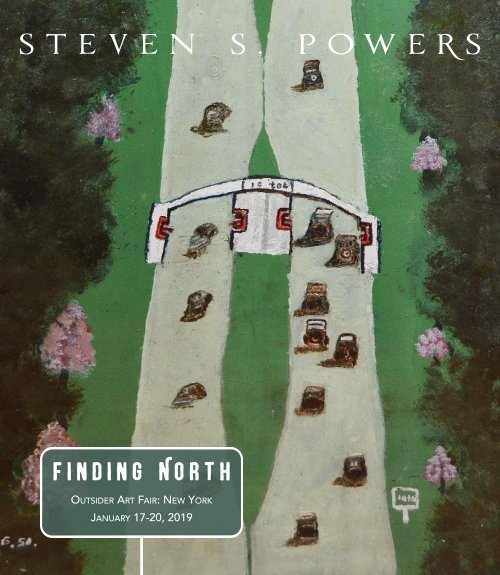

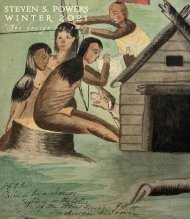
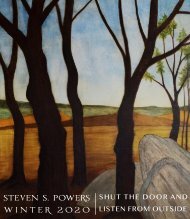
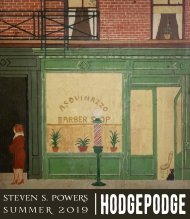

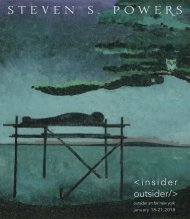
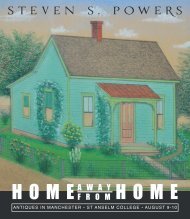
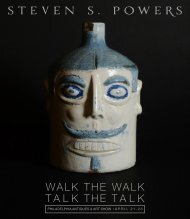
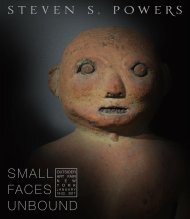
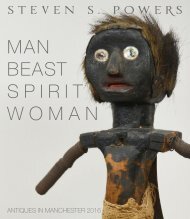
![NEEDLE • KNIFE • TORCH [&] BRUSH](https://img.yumpu.com/55309753/1/190x219/needle-o-knife-o-torch-brush.jpg?quality=85)
